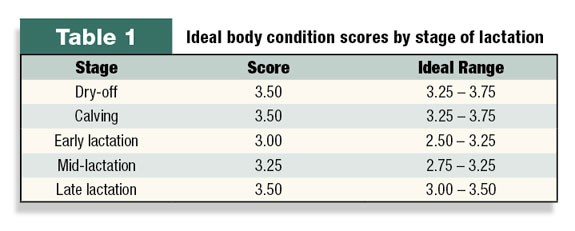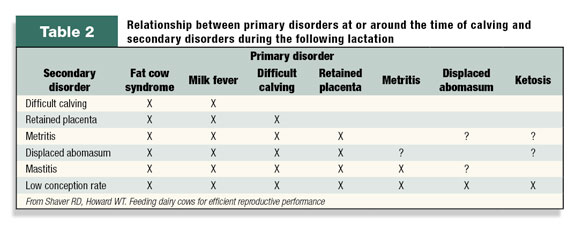Dairy producers many times find themselves in a balancing act when striving to maximize their reproductive and nutrition programs. Nutritional deficiencies and ration imbalances can lead to poor reproduction performance, but there are also many other factors to consider before altering your current nutrition program. Poor reproduction performance can also be the result of poor heat detection, time of insemination, insemination practices, diseases, toxins and other management-related problems.
To help find equilibrium in your herd, Dr. Stephen Emanuele, Balchem Corporation, suggests areas for dairy producers to focus on for a successful transition and breeding program.
- Optimize DMI throughout the transition period (three weeks before and after calving).
- Provide nutrients that support and enhance good liver function to prevent excessive build-up in the liver.
- Prevent excessive loss of body condition in the first 21 days after calving.
Importance of energy
Although it’s always nice to find a quick, easy solution to every problem, often it’s not the case when it comes to nutrition and reproduction interaction. Most reproductive problems related to nutrition can be traced to the transition period through the first few days in milk.
Energy plays the greatest role in reproduction performance and can easily tip your scale to one side or the other. During early lactation peak feed intake falls behind peak milk production. Milk production typically peaks at about six weeks into lactation, whereas feed intake peaks at about 10 weeks. This often leads to inadequate energy intake providing low levels of energy for functions beyond daily maintenance and milk production, like reproduction. On the other hand, excess energy intake during late lactation and the dry period can increase body condition score and lead to reproduction problems in the next lactation.
Most high-producing cows are in a negative energy balance during early lactation because they cannot consume enough feed to meet their energy requirements. A study at Cornell University examined the effect of negative energy balance in high-producing cows. The results indicated that the return of normal estrous cycle activity after calving depended on the energy balance in the first three weeks of lactation. The greater the negative energy balance, the longer time to first ovulation. Another Cornell study cited also noted that conception rate was 67 percent at the time of breeding for cows that were gaining weight, while it was 44 percent in cows that were losing weight.

Dairy producers should monitor body condition scores (BCS) of cows during different stages of lactation. In early lactation, cows should not lose more than 1 point of body condition. Using this scale, cows should calve with a BCS of 3.5 to 4.0 and milk down to a 2.5 or 3.0. (See Table 1.)
Cows that are overweight at calving have greater incidences of ketosis, retained placenta, urine infections and cystic ovaries. These problems also lead to a higher chance of metabolic disorders and going off- feed. Feed to keep your cows healthy during the transition period. Strive for less than 5 percent fat in the liver and high DMI without overconditioning animals. Strategies to achieve this include decreasing starch intake and maintaining low energy levels by limiting corn silage. As an alternative, use chopped wheat straw.
Cows that develop metabolic or nutritional disorders at or around calving have increased instances of developing secondary disorders during their lactation. The result is decreased fertility and longer days in milk.

Table 2 illustrates the relationship between primary disorders at or around the time of calving and secondary disorders during lactation.
Meeting protein needs
Reproduction can be greatly affected by both deficient and excess dietary protein. Protein deficiencies have the potential to increase the incidence of silent heats and lower conception rates. Cows that are deficient in protein will improve milk production after additional protein has been added to the diet.
Excess protein has been related to lowering conception rates, increasing services per conception and raising number of days open. In fact, research cited at Oregon State University indicates that cows fed excess protein – more than 10 to 15 percent above requirements – experienced more services per conception.
Below are guidelines for feeding protein:
- Balance the ration for crude protein according to the level of milk production – 1.0 pound crude protein per 10 pounds of milk.
- For high-producing and early lactation cows, 35 percent of the crude protein should be undegradable protein.
- Limit nonprotein nitrogen to 0.4 pounds urea equivalents per cow per day and blend with protein sources.
- Feed to improve protein and carbohydrate utilization:
- Feed grain 4 to 6 times per day.
- Feed forage before grain.
- Feed protein supplement along with grain.
- Feed a total mixed ration.
- Properly weigh and mix ingredients.
- Routinely test forages and balance rations.
Feeding minerals
Often mineral deficiencies and imbalances lead to poor reproductive performance. As reflected in reproduction performance and milk production, it is clear that adequate amounts of minerals and vitamins must be fed, but little is known about the effects of overfeeding minerals.
Calcium and phosphorus are both macrominerals that should be monitored closely. Calcium deficiencies could lead to milk fever, increased incidences of dystocia, retained placenta and prolapsed uterus. Phosphorous deficiencies decrease fertility, feed intake and milk production. Deficiencies can also lead to lower conception rates, decreased ovarian activity, irregular estrous cycles and increased occurrence of cystic ovaries.
Macromineral suggestions include (all percentages are on a dry matter basis):
- Balance rations for high-producing cows at 0.75 to 0.80 percent calcium.
- Increase calcium to 0.9 to 1.0 percent and magnesium from 0.25 to 0.30 percent when feeding supplemental fat.
- Balance rations for high-producing cows at 0.45 to 0.50 percent phosphorus.
An important concept surrounding macromineral balance is dietary cation-anion difference (DCAD). DCAD measures the level of four macrominerals: sodium and potassium, which are cations and carry a positive charge, and chloride and sulfur, which are anions and carry a negative charge. The equation for calculating DCAD balance is:
(sodium + potassium) – (chloride + sulfur) = DCAD in meq/100g of ration dry matter
Research shows that a negative DCAD prior to calving helps cows successfully join the milking string, decreasing the incidence of metabolic disorders postpartum and increasing early lactation production. By helping cows mitigate the challenges of the transition period, a negative DCAD helps maintain reproductive integrity for future lactations.
Trace minerals such as selenium, copper, zinc, iodine, manganese and cobalt are also essential and should be provided in the ration. Concentrations of trace minerals can be found in forages, grains and byproducts, but provide inconsistent amounts. Many producers meet half the requirements for trace minerals from supplemental sources such as trace mineral salt, premix or commercial mineral or feed.
The latest on essential fatty acids
Research continues to show the important role essential fatty acids (EFAs) – particularly Omega-3 and Omega-6 EFAs – play in reproductive performance. EFAs cannot be biologically produced by the cow, which means they must be supplied through diet supplementation.
EFAs are so critical because they influence multiple steps related to reproductive function. Linolenic acid (Omega-3) assists with prostaglandin production and fosters embryonic survival, and linoleic acid (Omega-6) promotes ovulation and sperm capacitation, aids in oviduct contraction and maintains embryo implantation.
Nutrition is a strong component in balancing an efficient reproduction program. The most important factor for a strong reproduction program is proper management of transition cows to insure that healthy cows are entering the herd. If these guidelines are followed, they will help you develop a strong reproduction program.
There are many factors that can influence a reproduction program, but research continues to show just how important nutrition is for success in reaching your herd’s reproduction goals. Work with your nutritionist to ensure cows are producing milk optimally while meeting reproductive goals. PD
References omitted due to space but are available upon request by sending an email to editor@progressivepublish.com.
—Excerpts from Dairy Cattle Reproduction Council newsletter,Vol. 3, No. 3





